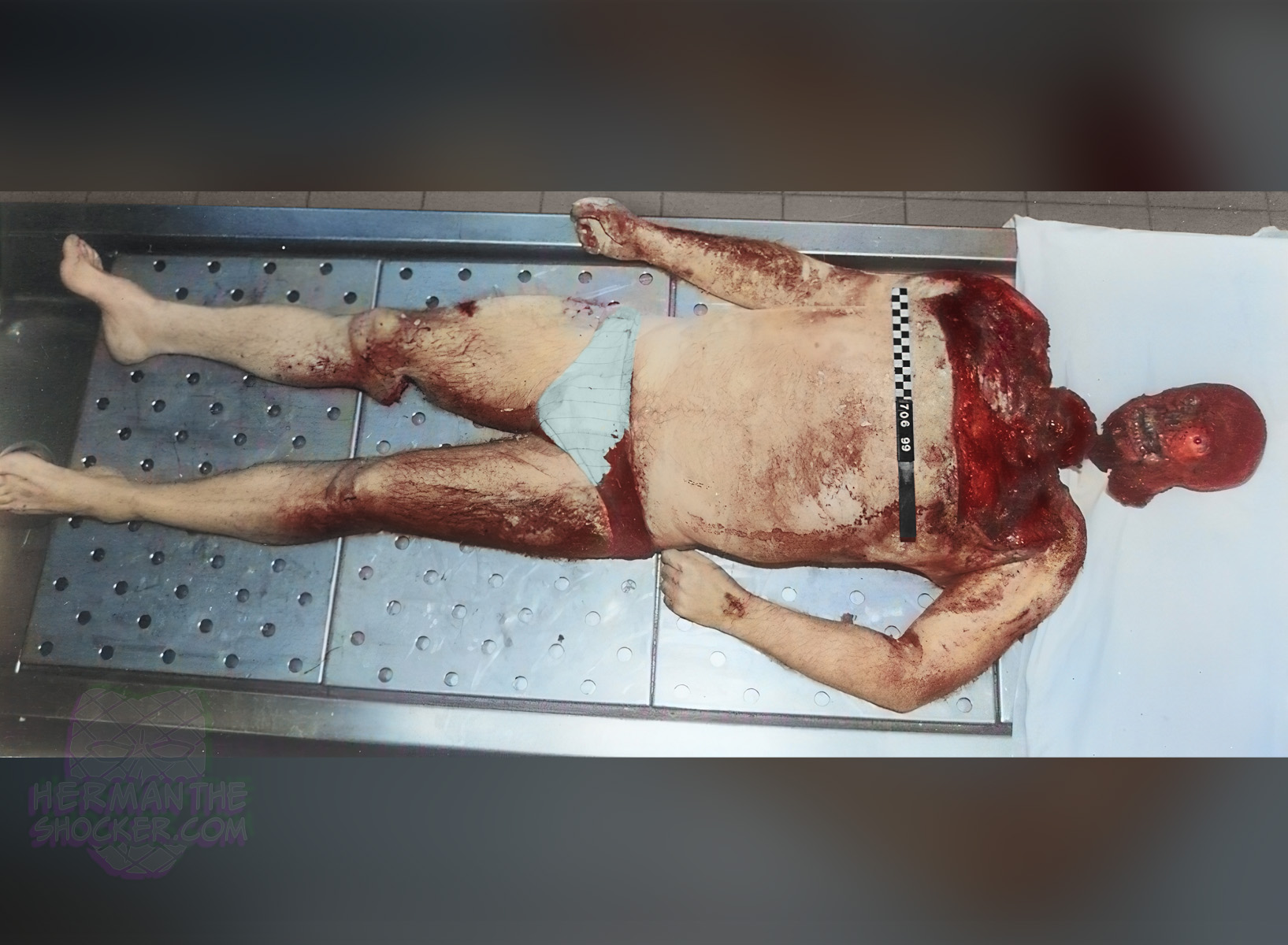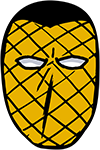I colorized the original black and white images.
Poland, 1999. A 26-year-old man killed his father by multiple puncture wounds to the chest and neck using a sharpened screwdriver. He lured his father into the cellar and, before inflicting the fatal strokes, he tried in vain to electrocute him using a stun gun. After this, he hung his father by the legs in a cellar window and decapitated him using a surgical scalpel and shovel. Additionally, he made deep incisions across the popliteal fosse to bleed the corpse and collected the blood from the cervical stump vessels in a bucket. He then took the separated head and neck upstairs to his room and scalped it through the whole night.
Afterward, he threw the head into the garden. Next, using a thread he sutured together the soft tissues of the head, additionally trying to repair them with a prosthetic plastic mass. He then dried the scalp using salt, thus preventing putrefaction. Subsequently, he placed this scalp–mask over his head, previously shaved and layered with stick tape. He put on his father’s clothes, hat, glasses, and scarf and left home to sit on a bench.
When his grandfather came by, he started a conversation with him pretending to be the father. The grandfather did not recognize him and was sure that he was talking with his son. After a while they even had breakfast together. Finally, the grandfather, surprised by the unnatural voice of his “son” and suspicious of his interlocutor, went into the cellar where he found the body and departed for a neighbor’s house to call the police.
The grandson, finding that the crime had come to light, left home, taking garments his father wore on the day of his death and found a hiding place nearby. He observed the scene and the investigation carried out by the police. He then sat on a bus stop bench, where he was later arrested.
The crime scene investigation revealed the corpse to be dressed only in underwear and hung fastened by the legs to the window frame with the upper limbs spread out on the floor as if crucified. The scalp of the head, neck, and upper chest, a sharpened screwdriver, and a shovel were found on the floor. In the first floor room, a needle and thread, surgical scalpel, prosthetic mass, and some small pieces of the scalp were found.
The head was separated from the neck at the level of the third cervical vertebra. The head was deprived of soft tissue; the eyeballs were in the orbits. The margins of the scalp fitted against the incisions of the skin on the upper part of the chest and neck. The scalp was dissected and sutured together along the facial and cranial vault midline. Along some length of the suture, the dissected margins were fastened together with dried prosthetic mass.
On the neck and the anterior part of the chest, multiple (approximately 15) puncture wounds, 0.3–0.4 mm wide, were seen, corresponding in shape and size to the screwdriver used in inflicting the injuries. The cause of death was exsanguination from wounds to the heart and lungs. Neither alcohol nor any toxicologic agents were detected in the blood of the deceased.
The perpetrator, who readily admitted his guilt, was an immigrant of Polish descent from one of the Russian republics. He had lived in Poland for some years, first alone as a student and later with his father and grandfather. His mother and sister were still in the old country. He studied medicine for 1 year, then psychology for 3 years, and finally dropped out. Subsequently, he was unemployed and was into sports training and reading. He hated his father and considered his attitude and life immoral.
According to the son, the father settled in Poland after fleeing from family revenge due to the fact that in the old country he had seduced a woman, 30 years his junior and a daughter of his own friend. The father left the boy’s mother and sister penniless and despite the fact that he himself was quite wealthy, he took no interest in their welfare and offered no assistance. In the young man, these facts caused intense aggression and hatred toward his father, which culminated in a decision to murder him.
The perpetrator testified that he planned the details of the murder and mutilation and prepared the tools in a cellar. The murder was to be “a work of art, illustrating extreme human meanness” and “an act with no holds barred.” The example for such a crime was set by the killer from the movie Seven, who “sacrificed himself,” punishing people for their sins and then confessing to the police. Wearing the scalp–mask on his own head was a kind of game the killer played with the grandfather to see whether he could be recognized.
Hanging the decapitated body in the position with the lower limbs up was to symbolize crucifixion on “an upturned cross” because “the head of this kind of scoundrel should not hang even on a devil’s cross.” He believed that “a man’s worth can be recognized in his values rather than on his face,” and so the scalping of his father, “a man who never recognized any values” was to symbolize his “lack of face.” Throwing the scalped head into the garden, where it rested among the weeds was, in his thinking, “throwing away the weed” and “freeing the body from the presence of the head” (through decapitation) was to symbolize the punishment, since “the head was guilty of everything.”
According to psychiatrists, the killer was diagnosed as having a “borderline” schizoid personality. Article 34.2 of the Polish Penal Code decrees that this sets considerable limitations on his capacity to understand the meaning of the offense and the ability to guide his behavior.
Latest posts
















